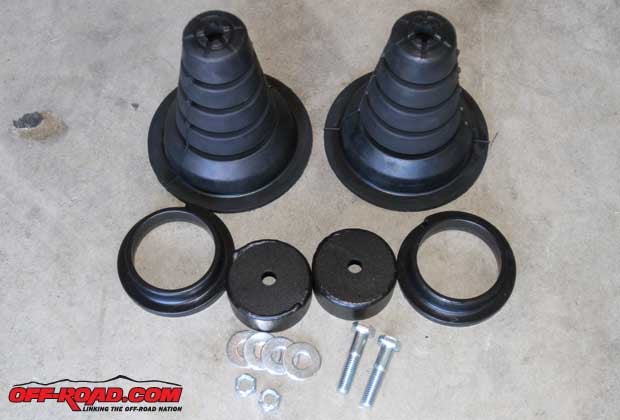Icon Vehicle Dynamics, Metal Tech 4x4 GX 470 Rear Suspension Install
In our last story chronicling our Lexus GX 470 project, we focused on upgrading the front suspension with new coilovers and upper control arms from Icon Vehicle Dynamics. Aside from the performance upgrade afforded by our new Icon shocks, they also offer additional lift for the front end for additional ground clearance and suspension travel.
It’s time to shift our time focus on the rear suspension, where we’ll be swapping out the stock air suspension and converting over to coil springs with parts from Metal Tech 4x4 and Icon, and we’ll also be upgrading the rig with new Icon shocks and trailing arms.
![]()
Our Icon Vehicle Dynamics Stage 7 package is a true bolt-on kit, as nothing needs to actually be modified short of a small hole drilled on each side of the frame for mounting the reservoir lines. Removing the rear air suspension system involves a few extra steps, however, so we wanted to break up the suspension upgrades into two parts to provide more detail on our installation.
![]()
![]()
With the GX 470 quietly growing in popularity (a trend we expect to continue), there are a number of coil conversions out there. Rear springs are included in our kit from Icon, and since we’d be adding a Metal Tech 4x4 rear bumper and spare tire carrier, we opted for the heavier 3-inch coil springs to compensate for the added weight.
![]()
![]()
Having the springs to replace the air bags is one thing, but there needs to be something to actually hold those springs in place. Fortunately, Metal Tech 4x4 offers a simple solution for doing so, with one option that includes the hardware necessary to hold the spring in place on the rear axle and another that includes both the hardware and what’s called a spring isolator, which is a large piece that looks very much like a bump stop that actually rests inside the coil spring and then sits just between the spring and the frame of the GX. Metal Tech 4x4 makes the process easy by offering a kit that includes the spring isolator and spring retainer hardware, though there is the option to source the isolator yourself (either new from a dealer or from a junkyard). Although we sourced the spring isolator, the complete Metal Tech 4x4 kit is the best bet for most because it makes the process simple.
![]()
![]()
![]()
![]()
![]()

![]()

![]()
![]()
![]()
![]()
![]()
![]()
![]()
![]()
![]()
![]()
Overall, the rear suspension upgrades we performed were pretty straightforward. As we noted in our front suspension story, we do not have a KDSS-equipped GX, which makes things a little simpler since there’s a few less parts to worry about. We did decide to remove the air suspension components entirely, as we have no plans to convert back to the system. For this installation, a competent garage mechanic can tackle it in roughly half a day, but as always, if it seems too daunting a task your local 4x4 shop can knock out the job in short order.
MORE GX 470 STORIES
Icon Vehicle Dynamics Front Suspension Installation
Luxury Off-Road: Why We’re Building a Lexus GX 470
SOURCES
Icon Vehicle Dynamics
951/689-4266
IconVehicleDynamics.com
MetalTech 4x4
503/822-1111
MetalTech4x4.com


 Your Privacy Choices
Your Privacy Choices